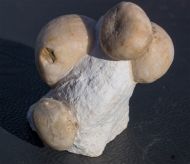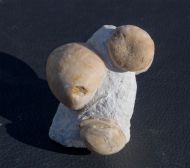Fossils for sale
Welcome back!
Sold:
Echinocorys gravesii (Desor, 1847), Conulus subrotundus Mantell, 1822 & Echinocorys gravesii (Desor, 1847)
Products description
| This is a fossil echnoid cluster from Wüllen with a larger Echinocorys gravesii and two specimens of the species Conulus subrotundus. The piece is rounded off by a fossil braciopod of that belongs to the species Najdinothyris becksi. The renowned site at the Hollekamp quarry in Ahaus-Wüllen was especially famous for its fossil "battlefields" of fossil sea urchins of the species Conulus subrotundus. Due to the partially slightly condensed sediments at this fossil site, these remarkable fossil clusters could form. Apparently, the lighter components of the still unconsolidated sediment were partially washed out, while the heavier sea urchin shells were swept together into depressions. These clusters of echinoid fossils are actually a local uniqueness. They were not that very rare at the time of active limestone mining. Today, the site is considered virtually extinct, and the quarry has been renaturalized. So new finds are unlikely. | |||
Location: | Hollekamp quarry, Ahaus-Wüllen, Germany | ||
| Size Piece: | about 53 x 42 x 35 mm | ||
| Age: | Upper Cretaceous, Turonian, Wüllen-Formation (about 90 Ma) | ||
Product no.: 11716





